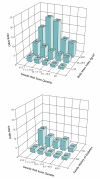Joint effects of common genetic variants on the risk for type 2 diabetes in U.S. men and women of European ancestry
- PMID: 19380854
- PMCID: PMC3825275
- DOI: 10.7326/0003-4819-150-8-200904210-00008
Joint effects of common genetic variants on the risk for type 2 diabetes in U.S. men and women of European ancestry
Abstract
Background: Genome-wide association studies have identified novel type 2 diabetes loci, each of which has a modest impact on risk.
Objective: To examine the joint effects of several type 2 diabetes risk variants and their combination with conventional risk factors on type 2 diabetes risk in 2 prospective cohorts.
Design: Nested case-control study.
Setting: United States.
Participants: 2809 patients with type 2 diabetes and 3501 healthy control participants of European ancestry from the Health Professionals Follow-up Study and Nurses' Health Study.
Measurements: A genetic risk score (GRS) was calculated on the basis of 10 polymorphisms in 9 loci.
Results: After adjustment for age and body mass index (BMI), the odds ratio for type 2 diabetes with each point of GRS, corresponding to 1 risk allele, was 1.19 (95% CI, 1.14 to 1.24) and 1.16 (CI, 1.12 to 1.20) for men and women, respectively. Persons with a BMI of 30 kg/m(2) or greater and a GRS in the highest quintile had an odds ratio of 14.06 (CI, 8.90 to 22.18) compared with persons with a BMI less than 25 kg/m(2) and a GRS in the lowest quintile after adjustment for age and sex. Persons with a positive family history of diabetes and a GRS in the highest quintile had an odds ratio of 9.20 (CI, 5.50 to 15.40) compared with persons without a family history of diabetes and with a GRS in the lowest quintile. The addition of the GRS to a model of conventional risk factors improved discrimination by 1% (P < 0.001).
Limitation: The study focused only on persons of European ancestry; whether GRS is associated with type 2 diabetes in other ethnic groups remains unknown.
Conclusion: Although its discriminatory value is currently limited, a GRS that combines information from multiple genetic variants might be useful for identifying subgroups with a particularly high risk for type 2 diabetes.
Primary funding source: National Institutes of Health.
Figures




Comment in
-
Understanding the combined effects of conventional risk factors and genetic loci on diabetes incidence.Ann Intern Med. 2009 Dec 1;151(11):824-5; author reply 825. doi: 10.7326/0003-4819-151-11-200912010-00022. Ann Intern Med. 2009. PMID: 19949155 No abstract available.
Summary for patients in
-
Summaries for patients. Using genetic and other factors to predict risk for type 2 diabetes.Ann Intern Med. 2009 Apr 21;150(8):I-40. doi: 10.7326/0003-4819-150-8-200904210-00004. Ann Intern Med. 2009. PMID: 19380850 No abstract available.
Similar articles
-
Association of a Genetic Risk Score With Body Mass Index Across Different Birth Cohorts.JAMA. 2016 Jul 5;316(1):63-9. doi: 10.1001/jama.2016.8729. JAMA. 2016. PMID: 27380344
-
A Genetic Risk Score Improves the Prediction of Type 2 Diabetes Mellitus in Mexican Youths but Has Lower Predictive Utility Compared With Non-Genetic Factors.Front Endocrinol (Lausanne). 2021 Mar 12;12:647864. doi: 10.3389/fendo.2021.647864. eCollection 2021. Front Endocrinol (Lausanne). 2021. PMID: 33776940 Free PMC article.
-
Combined effects of 17 common genetic variants on type 2 diabetes risk in a Han Chinese population.Diabetologia. 2010 Oct;53(10):2163-6. doi: 10.1007/s00125-010-1826-5. Epub 2010 Jun 17. Diabetologia. 2010. PMID: 20556352
-
Analysis of 32 common susceptibility genetic variants and their combined effect in predicting risk of Type 2 diabetes and related traits in Indians.Diabet Med. 2012 Jan;29(1):121-7. doi: 10.1111/j.1464-5491.2011.03438.x. Diabet Med. 2012. PMID: 21913964
-
Sexual Dimorphism of a Genetic Risk Score for Obesity and Related Traits among Chinese Patients with Type 2 Diabetes.Obes Facts. 2019;12(3):328-343. doi: 10.1159/000500490. Epub 2019 Jun 5. Obes Facts. 2019. PMID: 31167208 Free PMC article.
Cited by
-
Genetic predisposition to higher body mass index or type 2 diabetes and leukocyte telomere length in the Nurses' Health Study.PLoS One. 2013;8(2):e52240. doi: 10.1371/journal.pone.0052240. Epub 2013 Feb 12. PLoS One. 2013. PMID: 23424613 Free PMC article.
-
A methodological perspective on genetic risk prediction studies in type 2 diabetes: recommendations for future research.Curr Diab Rep. 2011 Dec;11(6):511-8. doi: 10.1007/s11892-011-0235-6. Curr Diab Rep. 2011. PMID: 21947855 Free PMC article. Review.
-
Evaluation of genetic susceptibility to childhood allergy and asthma in an African American urban population.BMC Med Genet. 2011 Feb 14;12:25. doi: 10.1186/1471-2350-12-25. BMC Med Genet. 2011. PMID: 21320344 Free PMC article.
-
Genetic risk assessment of type 2 diabetes-associated polymorphisms in African Americans.Diabetes Care. 2012 Feb;35(2):287-92. doi: 10.2337/dc11-0957. Diabetes Care. 2012. PMID: 22275441 Free PMC article.
-
Impact of Genetic Testing and Family Health History Based Risk Counseling on Behavior Change and Cognitive Precursors for Type 2 Diabetes.J Genet Couns. 2017 Feb;26(1):133-140. doi: 10.1007/s10897-016-9988-z. Epub 2016 Jun 14. J Genet Couns. 2017. PMID: 27296809
References
-
- Hogan P, Dall T, Nikolov P, American Diabetes Association Economic costs of diabetes in the US in 2002. Diabetes Care. 2003;26:917–32. [PMID: 12610059] - PubMed
-
- Kaprio J, Tuomilehto J, Koskenvuo M, Romanov K, Reunanen A, Eriksson J, et al. Concordance for type 1 (insulin-dependent) and type 2 (non-insulin-dependent) diabetes mellitus in a population-based cohort of twins in Finland. Diabetologia. 1992;35:1060–7. [PMID: 1473616] - PubMed
-
- van Dam RM, Hoebee B, Seidell JC, Schaap MM, de Bruin TW, Feskens EJ. Common variants in the ATP-sensitive K+ channel genes KCNJ11 (Kir6.2) and ABCC8 (SUR1) in relation to glucose intolerance: population-based studies and meta-analyses. Diabet Med. 2005;22:590–8. [PMID: 15842514] - PubMed
-
- Ludovico O, Pellegrini F, Di Paola R, Minenna A, Mastroianno S, Cardellini M, et al. Heterogeneous effect of peroxisome proliferator-activated receptor gamma2 Ala12 variant on type 2 diabetes risk. Obesity (Silver Spring) 2007;15:1076–81. [PMID: 17495182] - PubMed
Publication types
MeSH terms
Grants and funding
LinkOut - more resources
Full Text Sources
Medical
Molecular Biology Databases
